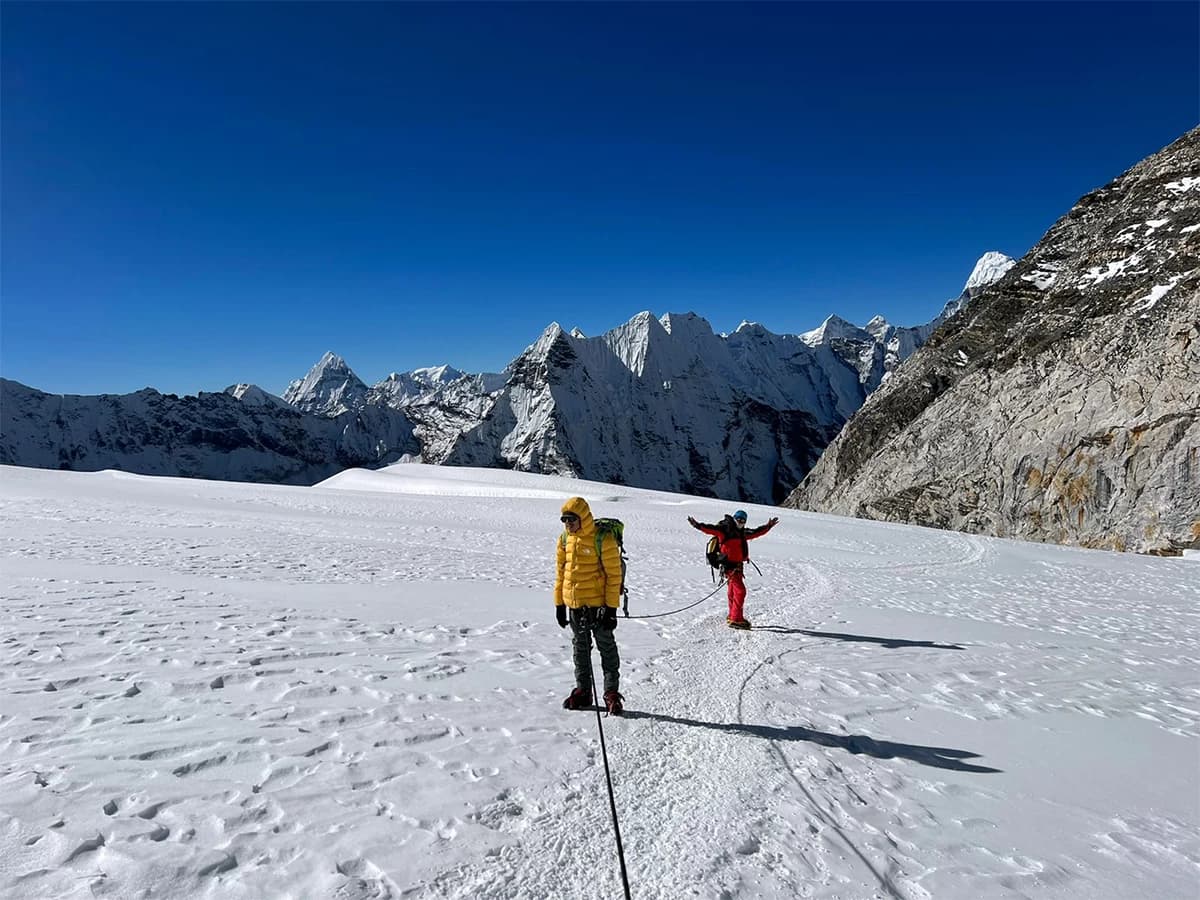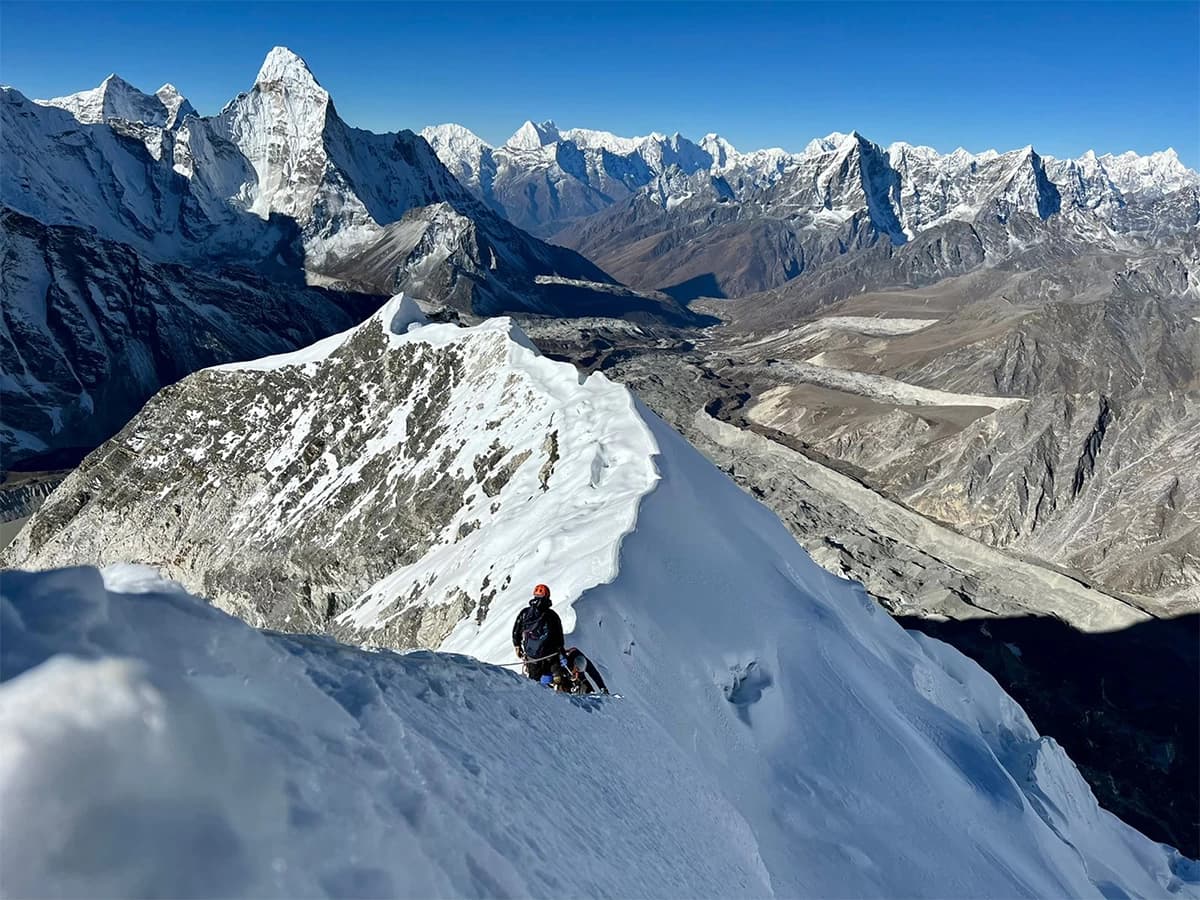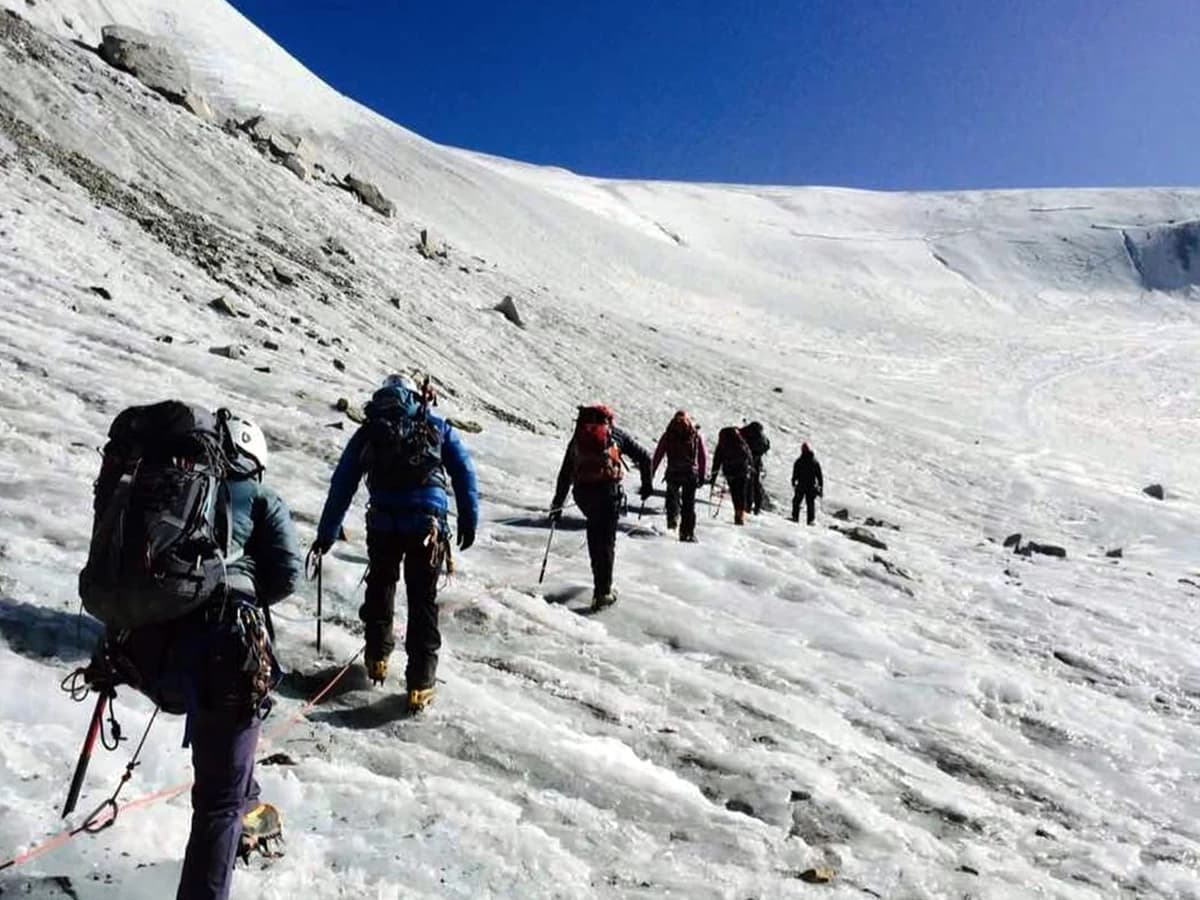Have you ever wondered what is beyond high-altitude trekking like Everest Three Passes, Annapurna Circuit, and Manaslu Circuit? Well, it is high-altitude peak climbing. As we all know, Nepal is famous for its mountains, so climbing is another most popular activity among foreigners in Nepal.
But climbing a peak in the Himalayas sounds scary, very difficult, time-consuming, and obviously expensive, right? This statement is both right and wrong. Right, because climbing a mountain involves all these factors.
Wrong, because there are also trekking peaks in Nepal that are mostly nontechnical, can be summited in 1-2 days from the base camp, cost a fraction of money, and the success rate is quite high. And Island Peak is one of those peaks.
Introduction to Island Peak climbing
Island Peak, locally known as Imja Tse, is a spectacular 6,189 meters (20,305 ft) peak tucked away in the Chhukung Valley, Everest region. It is a trekking peak, which means it is ideal for beginner climbers or for those transitioning from hiking to mountaineering.
Island Peak climbing offers an excellent blend of trekking and climbing. Though our Island Peak climbing itinerary doesn't include hiking to the Everest Base Camp and Kala Patthar, you can definitely customize the itinerary.
The journey starts with the famous Lukla flight from Kathmandu. From Lukla, you will gradually ascend the Khumbu Valley alongside the Dudh Koshi River, spending nights in beautiful Sherpa villages like Phakding, Namche Bazaar, Tengboche, and Dingboche.
Dingoche onwards, the trail splits off the mainstream EBC route, which thousands of trekkers follow, and continues along a peaceful, offbeat track that will lead you to Chhukung Valley. You will spend two nights in Chhukung village before moving ahead to Island Peak Base Camp.
While in Chhukung, you will go on an acclimatization hike to Chhukung Ri. From here, you will see a great view of the south wall of Lhotse and many other mountains. There is also an alternative hiking option to Kongma La Pass. The highlight of this trip is definitely climbing the Island Peak.
From Chhukung village, the trail ascends to Island Peak Base Camp. On the same day, you will leave for the summit push around 12:00 AM to 1:00 AM and return to Chhukung village. Summit day will be the longest and most challenging. After climbing Island Peak, you will retrace the trail to Lukla and fly back to Kathmandu.
Our acclimatization routine for Island Peak climbing
Before we share our acclimatization routine for Island Peak climbing, let's discuss a frequently asked question by our climbers: Why do you have to trek? Why can't you just take a helicopter flight from Kathmandu to Island Peak Base Camp and move ahead with climbing?
It is because of acclimatization. Hiking gradually allows you to adjust to high altitudes and avoid altitude sickness. It increases the summit's success rate and ensures a satisfying and safe journey.
Unlike bigger mountains, you do not spend multiple days at Island Peak Base Camp acclimatizing, so trekking allows you to get used to high altitude, and by the time you begin climbing, you will be acclimatized and mountain fit.
*Climbers of all ages and fitness can suffer altitude sickness if they ignore acclimatization.
Following our Island Peak itinerary, you will
- Spend an acclimatization day in Namche Bazaar and hike to the Hotel Everest View.
- Spend an acclimatization day in Chhukung village and hike to the Chhukung Ri viewpoint.
- Ascend slowly, maintaining a uniform pace and getting used to the alpine environment.
Who should climb Island Peak?
There are a handful of factors that determine whether climbing Island Peak is suitable for you or not. Follow the below guideline to assess if Island Peak climbing is suitable for you or not:
- Step into mountaineering: There is always a starting point for everything, and the same goes for mountaineering. No one climbs Mount Everest or K2 in their expedition. You must build your fitness, experience, and confidence before aiming for 8000. Island Peak offers a perfect introduction to mountaineering without technical climbing. So, if this is your first time climbing, Island Peak can be a great option.
- Adventure seeker: There is no boundary for adventure seekers, and climbing a peak in the Himalayas is one of the ultimate adventures.
- Tired of trekking and looking for the next adventure?: If you fall into this group, the trekking peak is your answer. And among all the trekking peaks in Nepal, Island Peak is an excellent choice.
- Physical and mental fitness: Physical and mental fitness are the foundation of safe and successful climbing. If you are not fit, none of the above reasons matter. So, anyone who is thinking about climbing Island Peak must be physically and mentally fit.
- Previous high altitude experience: Like physical and mental fitness, previous high altitude exposure is also a must and non-negotiable. If this is your first high-altitude trip, consider doing a few treks before climbing Island Peak.
Highlights
- Start and end the journey with thrilling Lukla flights
- Climb Island Peak, one of the best 6000 meters trekking peaks in Nepal
- Trek through the scenic valleys and beautiful Sherpa villages
- Cross several suspension bridges over the Dudh Koshi River and ascend through rhododendron forests
- Enjoy the mountain lifestyle and see the culture and traditions of mountain communities closely
- Visit Tengboche monastery and explore many stupas, chortens, and prayer wheels along the trail
- Fantastic acclimatization plan with two rest days
- Explore the diverse vegetation of Sagarmatha National Park
- Get pre-climbing training from your guide before the summit push
- Traverse glaciers, learn to use fixed ropes, climb ice walls, and experience an extreme alpine environment
- Witness beautiful landscapes and mountain vistas
- A perfect trip for adventure lovers and individuals who want to go beyond trekking in the Himalayas
- Hone your climbing skills and get ready for bigger mountains
Why choose Island Peak over other trekking peaks?
Island Peak was first climbed in 1953 by Sir Edmund Hillary and Tenzing Norgay Sherpa (the iconic duo who summited Mount Everest for the first time in human history). They have used Island Peak as their practice peak. So, climbing Island Peak is like becoming part of the history.
Second, compared to Mera Peak, Lobuche Peak, and Pisang Peak, the Island Peak climbing trip is shorter. Likewise, you will get a taste of technical climbing, which is not possible on other trekking peaks.
Island Peak climbing training and preparation
Climbing Island Peak is physically very demanding. You will be exposed to an extreme alpine environment, which literally deteriorates the human body and weakens it. Therefore, you have to be physically and mentally ready for the high altitude and thin air.
Exercise and exercise a lot. Build your strength, stamina, and endurance. Create a workout regime combining strength training and cardiovascular exercises and stay consistent. In addition, go on high-altitude day hikes and frequent long walks.
If you have access to a specific climbing training program that teaches the basics of mountaineering, join it. The more you know about climbing and climbing gear, the more confident you will be in the mountains. Likewise, you can also read related blogs and watch YouTube videos.
Our best advice is to book your Island Peak climbing trip at least 2 to 3 months early and stay in touch with your climbing agency while preparing for the voyage. Get into shape, budget the expenses, and arrange the trekking/climbing clothes and gear.
Safety measures and emergency evacuation plan
Your safety is our priority during the Island Peak expedition. You will climb with a professional Nepali climber who has climbed Island Peak several times before and is well aware of the climbing route.
From traversing glaciers to fixing ropes and climbing ice walls, our guide will help you in every step. To this date, we have helped many climbers summit Island Peak.
During our previous expeditions, we encountered many hurdles, which made us knowledgeable of all possible scenarios and experts in handling unseen events, so you can travel without any worry.
We have a perfect acclimatization plan, and our guides are trained to provide first aid. Likewise, during an emergency, we are also capable of providing quick rescue. With the Base Camp Trip, you can travel confidently.
Why climb Island Peak with Base Camp Trip?
- Best Island Peak climbing package: There are many Island Peak climbing packages on the market, but this one is the best. It is because of our service and easy acclimatization itinerary.
- Professional mountaineer as a guide: You will climb Island Peak with a professional mountaineer who has summited this peak many times before. It ensures the best experience and a high success rate.
- Supported by local Sherpa porters: No expedition in the Himalayas is completed without the help of porters. They carry heavy duffel bags, set tents, prepare meals, help fix the route, and share their stories.
- Island Peak climbing 13 days itinerary: Have you ever thought you could climb a peak in under two weeks? Well, our 13-day Island Peak itinerary is ideal for travelers on short vacations.
- Genuine Island Peak climbing cost: Factors like trip duration, group size, services, etc, affect the Island Peak climbing package cost. Instead of going after low prices or hoping for the best service because of the expensive package, we recommend participants check what they are getting in their package, how experienced your climbing agency is, how well they communicate with their guests, and check their reviews. By being a little proactive, you can ensure value for the price you pay, not to mention our Island Peak climbing cost is the best in the market.
- Pre-climbing training: We provide pre-climbing training at the Island Peak Base Camp. Led by your guide, the training aims to make you mountain-aware, teach you the basics of mountaineering, and introduce you to climbing gear and terms that will boost your confidence on your way to the summit.
- 24/7 support, a reliable management team, airport pick-ups and drop-offs, and a sustainable trip.
- Book private or group Island Peak climbing: 2025 and 2026 bookings are open for Island Peak climbing. You can join our fixed departure group or climb privately with our professional climbers.




